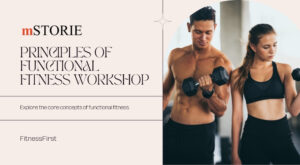Functional fitness is a training approach that focuses on exercises which mimic everyday movements to enhance overall strength, flexibility, and endurance. Unlike traditional gym workouts that often isolate specific muscle groups, functional fitness aims to improve your ability to perform daily activities more efficiently and with less risk of injury. Here, we’ll explore the principles, benefits, and practical applications of functional fitness.
Principles of Functional Fitness

- Multi-joint Movements: Functional exercises often involve multiple joints and muscles working together, similar to movements performed in daily life. Examples include squats, lunges, and push-ups.
- Balance and Stability: These exercises improve core strength and stability, which are crucial for maintaining balance and preventing falls. Planks and single-leg stands are good examples.
- Flexibility and Mobility: Functional fitness emphasizes full range of motion to enhance flexibility and mobility, helping you move more freely. Yoga and dynamic stretching routines are beneficial.
- Practicality: The exercises are designed to improve real-world strength, making it easier to perform tasks like lifting groceries, climbing stairs, or playing with your kids.
Benefits of Functional Fitness
- Injury Prevention: By strengthening the muscles and improving coordination, functional fitness reduces the risk of injuries in daily activities.
- Improved Posture: Functional exercises can help correct imbalances and improve posture, reducing back pain and enhancing overall comfort.
- Increased Strength and Endurance: This type of training builds overall strength and endurance, making everyday tasks less taxing.
- Enhanced Mobility: Improved flexibility and joint mobility can make movements smoother and more efficient.
- Better Balance and Coordination: Functional fitness enhances balance and coordination, essential for safe and effective movement.
Practical Applications and Exercises
Daily Activities
- Lifting: Practice deadlifts and squats to simulate lifting heavy objects off the ground, ensuring proper form to protect your back.
- Carrying: Farmer’s walks involve carrying weights in each hand, improving grip strength and endurance for carrying groceries or luggage.
- Reaching and Twisting: Incorporate exercises like wood chops and medicine ball throws to enhance your ability to reach and twist.
- Climbing Stairs: Step-ups and lunges strengthen the muscles used for climbing stairs, improving leg strength and cardiovascular fitness.
Sample Functional Fitness Routine
- Warm-Up
- Dynamic stretches (arm circles, leg swings)
- Light cardio (jumping jacks, brisk walking)
- Strength and Balance
- Squats (3 sets of 12)
- Push-Ups (3 sets of 10)
- Planks (3 sets of 30 seconds)
- Single-Leg Deadlifts (3 sets of 10 per leg)
- Mobility and Flexibility
- Hip Bridges (3 sets of 15)
- Cat-Cow Stretch (3 sets of 10)
- Seated Forward Bend (hold for 30 seconds)
- Cool-Down
- Static stretches (hamstring stretch, quad stretch)
- Deep breathing exercises
Conclusion
Functional fitness is a versatile and practical approach to exercise that focuses on improving your ability to perform everyday tasks. By incorporating multi-joint movements, balance, stability, flexibility, and mobility into your routine, you can enhance your overall strength and reduce the risk of injury. Whether you’re lifting groceries, playing with your children, or simply moving through your daily routine, functional fitness can help you do it more efficiently and safely.
By focusing on real-world applications and incorporating functional exercises into your fitness regimen, you can build strength and resilience that extend far beyond the gym.
To read more articles, please visit our website https://www.mstorie.com/













